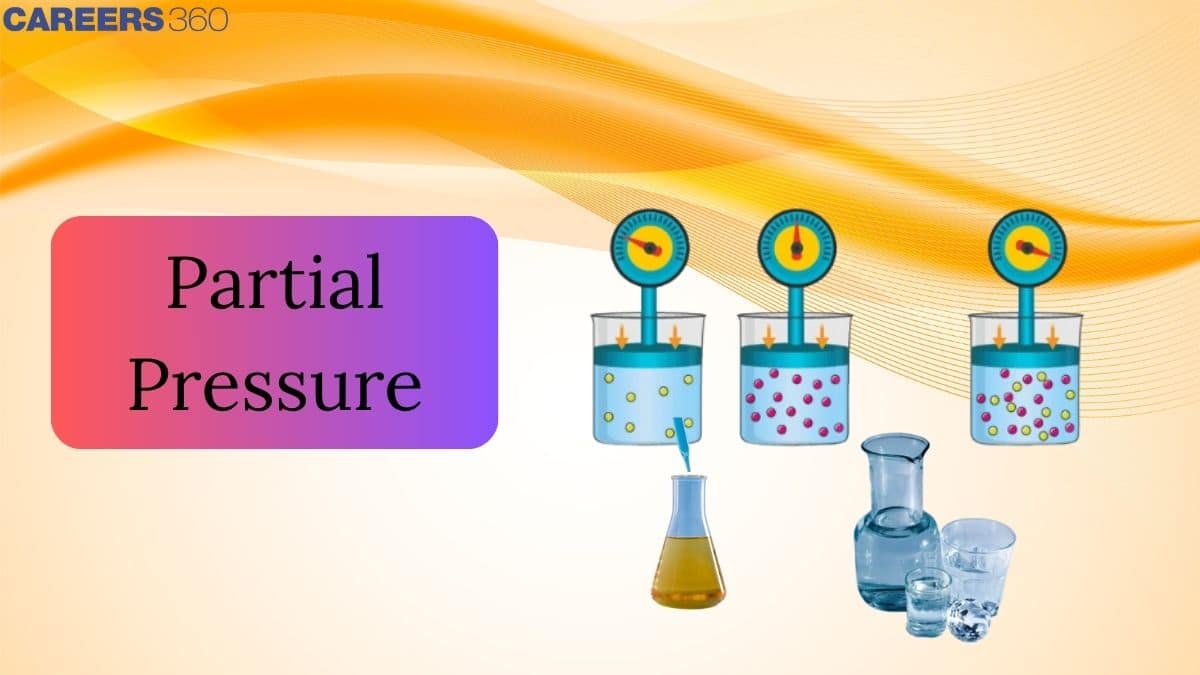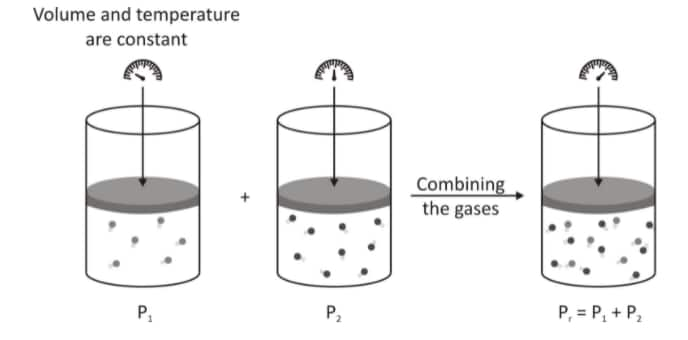Partial Pressure - Dalton’s Law, Application, Formula, Units, FAQs
John Dalton in 1801, discovered that the pressure of the mixture of non-reacting gases is equal to the sum of the partial pressure of the individual gases.This is under the ideal gas assumption wherein gases have no chemical interaction with one another. Dalton’s Law is very important in the study and estimation of the pressure of gas mixtures in different scientific and industrial contexts, including atmospheric investigation, collecting a gas over water, and respiratory mechanisms. It is a straightforward, yet powerful method of correlating the pressure of a single gas to the total pressure of a mixture.
This Story also Contains
- Dalton’s Law of Partial Pressure Applicability-
- Partial Pressure Formula
- Units of Partial Pressure-
- Recommended topic video on (Partial Pressure)
- Some Solved Examples

Partial pressure is the pressure exerted by an individual gas present in a mixture of gases, provided that the gases should be non-reactive.
The partial pressure of an individual gas is determined by a formula
$\mathrm{p}_{\mathrm{n}}=\mathrm{X}_{\mathrm{n}} \mathrm{p}_{\text {total }}$
Partial Pressure is defined as the pressure exerted by an individual gas in a mixture of non-reactive gases.
Partial pressure is the pressure that is not total, but only the pressure of an individual gas is taken out of the total pressure of mixed gases. This pressure is called partial pressure.
The partial balancing means balancing partially reciprocating masses.
Dalton’s Law of Partial Pressure-
Dalton was the first scientist to state that the pressure of gas doesn’t depend on the nature of the gas. Just how pure gases obey gas laws, a mixture of gases also obey gas laws i.e., gas laws apply to oxygen as well as air.
Each non-reacting gas present in the air contributes to the total pressure in proportion to a fraction (in moles). This contribution of each gas is known as the partial pressure of the gas.
Dalton stated that the total pressure of a non-reactive gaseous mixture will be equal to the sum of partial pressure of each gas.
$P_{\text {total }}$ is the total pressure of the gases and p1, p2, p3 .. are the partial pressure of each gas. Partial pressure is the same pressure exerted by an individual gas if the gas is contained in a jar of the same volume and temperature.
Dalton’s law of partial pressure is not applicable to the mixture of gases that reacts with each other.
Also read -
- NCERT Solutions for Class 11 Chemistry
- NCERT Solutions for Class 12 Chemistry
- NCERT Solutions for All Subjects
Application of Dalton’s Law of Partial Pressure of Gas-
The pressure of gases over the surface of the liquid can be calculated by using Dalton’s Law of partial pressure. The total pressure of a mixture of gas and water will be equal to atmospheric pressure if the water level inside and outside the vessel are equal.
The gas present over water exerts combined pressure due to its vapor pressure and due to the pull of gravity. This gas contains water vapors. The pressure of dry gas can be calculated easily using the following equation.
When the level of water gets equal on the inside and outside-
$\begin{gathered}P_{\text {atm }}=P_{\text {total }} \\ P_{\text {total }}=P_{\text {gas }}+P_{\text {water }} \\ P_{\text {gas }}=P_{\text {atm }}-P_{\text {water }} \\ P_{\text {water }}=\text { Aqueous tension }\end{gathered}$

The vapor pressure of a gas is different at different temperatures; therefore, Pwater is known.
Aqueous tension is the pressure exerted by water vapors. This Aqueous tension is the vapor pressure. Vapor pressure is the pressure exerted by the vapors of the liquid. Above the surface of a liquid, there always exist vapors of that liquid which exist in equilibrium with the water.
Dalton’s Law of Partial Pressure Applicability-
Dalton set a restriction for gases obeying Dalton’s law of partial pressure.
Gases of the mixture should not react with each other. Some gases like ammonia (NH3 and HCl) react with each other to form products like ammonium chloride (NH3Cl). Therefore, Dalton's law of partial pressure does not apply to such gases.
Similarly, gases like Hydrogen(H2) and chlorine (Cl2) react to form hydrogen chloride (HCl).
Related Topics Link:
| Colligative Properties Relative Lowering of Vapour Pressure | Supersaturated Solution |
| Henry's Law | Unsaturated Solutions |
| Types of Solutions |
Partial Pressure Formula
Let there be a container with gas A and gas B inside it. Gas A and Gas B will have partial pressure pa and pb.
According to the ideal gas equation-
$\begin{aligned} & \mathrm{p}_{\mathrm{a}}=\mathrm{n}_1 \mathrm{RT} / \mathrm{V} \\ & \text { And } p_b=n_2 R T / V\end{aligned}$
Here, n1 and n2 are the numbers of moles of gases present in the container.
the total pressure of a mixture of two gases is given by-
$\begin{gathered}\mathrm{P}_{\text {total }}=\mathrm{P}_1+\mathrm{P}_2 \\ =\mathrm{n}_1 \mathrm{RT} / \mathrm{V}+\mathrm{n}_2 \mathrm{RT} / \mathrm{V} \\ =\left(\mathrm{n}_1+\mathrm{n}_2\right) \mathrm{RT} / \mathrm{V}\end{gathered}$
Dividing p1 by ptotal -
$\begin{aligned} & \mathrm{p}_1 / \mathrm{p}_{\text {total }}=\left(\mathrm{n}_1 / \mathrm{n}_1+\mathrm{n}_2\right) \mathrm{RTV} / \mathrm{RTV} \\ & \mathrm{n}_1 / \mathrm{n}_1+\mathrm{n}_2=\mathrm{n}_1 / \mathrm{n}_2=\mathrm{x}_1\end{aligned}$
Where X1 is the mole fraction of the first Gas.
$p_1=X_1 p_{\text {total }}$
For both gases A and B,
The general equation can be written as-
$p_n=X_n p_{\text {total }}$
This is the formula of partial pressure of any gas.
Where pn is the partial pressure of nth gas and xn is the partial pressure of nth gas.
Also Read:
- NCERT solutions for Class 12 Chemistry Chapter 2 Solutions
- NCERT Exemplar Class 12 Chemistry Solutions Chapter 2 Solutions
- NCERT notes Class 12 Chemistry Chapter 2 Solutions
Units of Partial Pressure-
Partial pressure units are the same as the units of normal pressure.
The barometer is the instrument used in the lab to measure the pressure. The height of mercury determines the atmospheric units.
The barometer is assembled using a glass tube. This glass tube is closed from one end and open from the other end. Glass tube is filled with pure mercury. Glass tube is inverted into an open vessel containing mercury. The level of mercury drops until the atmospheric pressure acting outside the glass tube becomes equal to the pressure inside the tube.
If the height of the column decreases then atmospheric pressure increases and if the height of the column increases then the atmospheric pressure decreases.
It is the maximum height of mercury that determines the pressure. The height keeps falling and raising due to the changes from time to time.
Consider mercury-filled in an inverted glass tube of h cm and area of cross-section be equal to a cm2
We know that
pressure=force/area
Force $=$ mass $\times$ acceleration
pressure=mass $\times$ acceleration/area
$
\begin{aligned}
& \mathrm{P}=\mathrm{mg} / \mathrm{A} \\
& P=d \times V \times g / A
\end{aligned}
$
$
\begin{gathered}
\mathrm{P}=\mathrm{d} \times \mathrm{A} \times \mathrm{h} \times \mathrm{g} / \mathrm{A} \\
=\mathrm{hdg}
\end{gathered}
$
where d is the density, h is the height, g is the gravity, and A is the area.
1 atm is the pressure that supports a mercury height of 76 cm at 0°C
Recommended topic video on (Partial Pressure)
Some Solved Examples
Example 1.Equal weighs of ethane and hydrogen are mixed in an empty container at 25∘C The fraction of the total pressure exerted by Hydrogen is -
Options
a) 1:2
b) 1:1
c) 1:16
d) 15:16
Answer 1
let Xg of each gas is mixed.
$
\begin{gathered}
\text { mole of ethane }=\frac{x}{30} \\
\text { mole of hydrogen }=\frac{x}{2}
\end{gathered}
$
$
\begin{aligned}
\therefore \text { Mole fraction of hydrogen } & =\frac{x / 2}{x / 2+x / 30}=\frac{15}{16} \\
\Rightarrow \frac{\text { partial pressure of } H_2}{\text { Total pressure }} & =\text { mole fraction of Hydrogen } \\
= & 15: 16
\end{aligned}
$
Example 2.
At definite temperature, the tootal pressure of a gas mixture consisting of three gases A,B and C are 2,4,and 6 , then the increasingorder of their partial pressure is ___
a) $P_A=P_B=P_C$
b) P $_{\text {A }}>$ P $_{\mathrm{B}}>$ P $_{\mathrm{C}}$
c) P $_{\mathrm{A}}<$ P $_{\mathrm{B}}<$ P $_{\mathrm{C}}$
d) $P_A \neq P_B \neq P_C$
Answers (a)
The mole fractions of $A, B$, and $C$ in the mixture,
$
\begin{aligned}
& x_A=\frac{2}{12}=\frac{1}{6} \\
& x_B=\frac{4}{12}=\frac{1}{3} \\
& x_C=\frac{6}{12}=\frac{1}{2}
\end{aligned}
$
Therefore, the partial pressure of gas A,
$
\begin{aligned}
\underline{P_A} & =\frac{P}{6} \\
P_B & =\frac{P}{3} \\
\hline P_c & =\frac{P}{2} \\
\therefore \mathrm{P}_{\mathrm{A}}<\mathrm{P}_{\mathrm{B}}<\mathrm{C} &
\end{aligned}
$
Practice more questions from the link given below
For more questions to practice, the following MCQs will help in the preparation for competitive examinations
NCERT Chemistry Notes:
Frequently Asked Questions (FAQs)
It is used in:
Scuba diving (calculating partial pressures of breathing gases like O2 and N2).
Industrial gas mixtures (e.g., medical gases, fuel mixtures).
Meteorology (studying atmospheric gas compositions).
The key assumptions are:
The gases do not chemically react.
The gases behave ideally (no intermolecular forces).
The gases are at the same temperature and volume.
When a gas is collected over water, the total pressure is the sum of:
The pressure of the dry gas
The vapor pressure of water (which depends on temperature)
Ptotal =Pgas +Pwater
To find the pressure of the dry gas alone, subtract the water vapor pressure from the total pressure.
Oxygen has a partial pressure of 160 mm of Hg. The standard value is where 1 atm of pressure is supported by 760 mm of Hg at sea level. 760 mm of Hg is the height of mercury in a glass tube which supports a height of 760 mm of Hg. Depending on the changing time and place height of mercury keeps changing.
The partial pressure of helium is 203 mm of Hg and oxygen has a partial pressure of 160 mm of Hg.